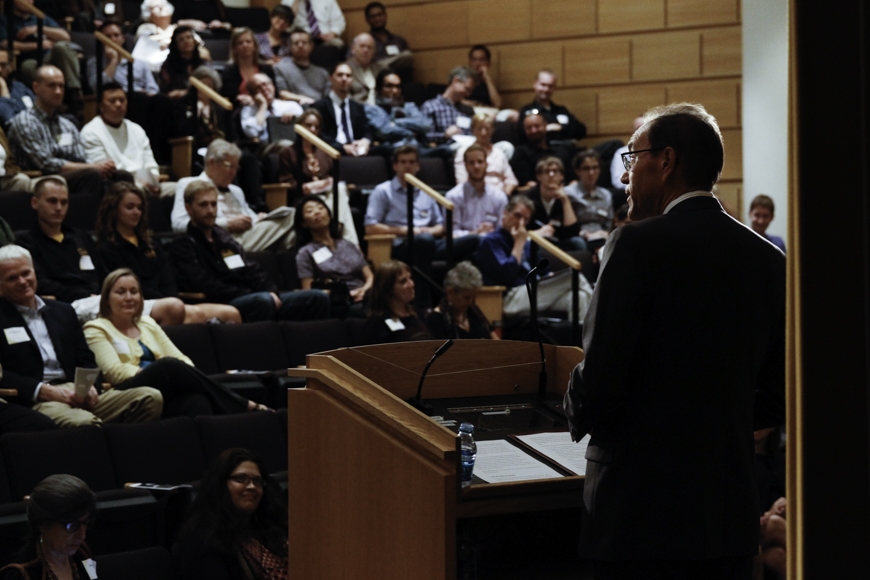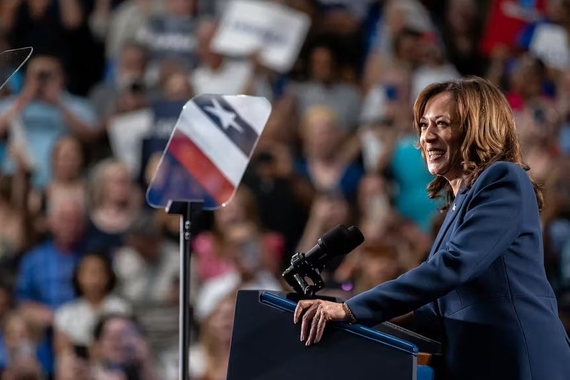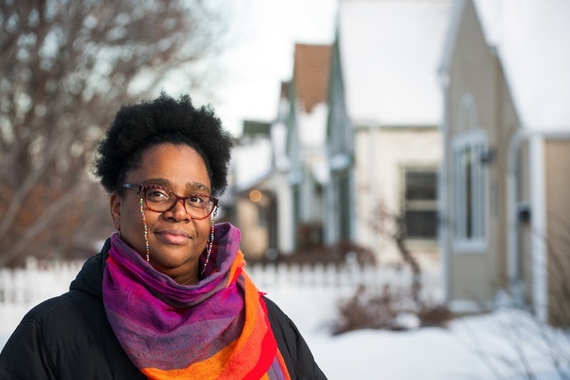State of the College 2014
TUESDAY, SEPTEMBER 23, 2014
Part 1: Looking Back
Welcome! It’s great to be here with you, as we celebrate the past, present, and future of the College of Liberal Arts.
In considering what I would say today, it occurred to me that this event is in many ways symbolic of the College at this moment in time.
The first meeting of the CLA Assembly each fall is rich with tradition. Each September, we gather to celebrate the successes of the past year and set our course for the new one. New faculty are introduced and welcomed into our community.
Just as this meeting itself represents the fusion of tradition and new beginnings, I hope that by discussing these themes and considering what brought us to where we are now, we can begin to determine where we wish to go.
Today isn’t about identifying solutions to specific problems, or getting down in the weeds. At next month’s aptly named “The Road Ahead” event on October 22nd, I’ll speak in more detail about specific steps we’ll take to move CLA forward and to align CLA with the University’s strategic plan, which will be approved by the Board of Regents shortly prior to that event.
But today is my opportunity to introduce myself—to explain the way I approach decisions, identify the values and priorities that guide my thinking, and share what I’ve learned about the challenges and opportunities we have here at CLA.
First, I’d like to take a few minutes to talk about what makes this college great and how we’ve gotten to where we are. Here are some highlights across our research, teaching, service and outreach from the past year:
The Shanghai “Academic Ranking of World Universities” ranked social sciences at the University of Minnesota 12th best in the world, and 3rd among US public universities.
Our Department of Asian Languages & Literatures was selected to be the 12th Chinese language department in the nation offering a Chinese Flagship Program. Flagship Program grants are awarded by the Department of Defense and Institute of International Education and provide funds for the training of undergraduate students to attain the highest level of proficiency in Chinese language while pursuing their bachelor degrees. The program includes both home and abroad study, with a capstone year at a Chinese university.
The Department of Theatre Arts and Dance and the Guthrie Theater negotiated a 10-year extension for their innovative BFA Actor Training Program, which merges a core of theatre courses with artistic training and a full liberal arts curriculum.
CLA earned a 2013-2014 U of M Alumni Association award for our series of alumni/student career development programs. The award recognizes the efforts and support of CLA Alumni Society volunteers, and honors the vision and hard work of CLA Student Board leaders & volunteers and CLA Career Services staff.
Thanks to generous donors, CLA’s Undergraduate Internship Grant Program was able to award $1,500 in financial support to more than 60 students conducting unpaid internships.
And lastly, CLA faculty won a total of 115 awards across research, teaching and service—60 internal and 55 external. Our students and and staff won numerous awards as well.
These are just a few examples out of many. Thank you all for everything you’ve done to bring us to where we are today. There’s a lot to be proud of.
What underlies all of these accomplishments is our deep commitment to the vibrancy and contributions of the liberal arts. Since my first day here I have been emphasizing that whether on campus or off campus, we will be on offense—and not defense—when talking about the College and the liberal arts. We will advocate, not apologize.
My confidence in our success is not drawn solely from my own convictions, but from all of you. Even during my first visit to campus, I was struck by the drive and tenacity of this community. Even when expressing challenges and concerns, there was a sense of determination, a belief that the College was poised to thrive if we set out on a clear path. When I later accepted the deanship, I wanted to learn more about what fueled this determination.
Across the months before arriving on campus, and since then as well, I’ve listened to numerous faculty, chairs, directors, recently tenured faculty, administrative leaders, undergraduate and graduate students, and staff from across the College. I’ve been fortunate to have conversations with some of our most generous donors and most distinguished alumni. And in every case, I’ve tried to let YOU do most of the talking.
The conversations covered the College as a whole, as a community and institution, as well as the challenges and opportunities at the unit level; and the experience of being an alum, staff member, faculty member, or student at the individual level, working within this community and institution. I am still learning. Whatever you have to say, I want to hear it.
You should know that this isn’t a one-time, out-of-the-gate goodwill gesture. As dean, I’m committed to keeping my decisions transparent and myself accessible through multiple channels. Over the coming year and beyond, I hope you’ll participate in staff lunches and my open office hours. We’ll be launching an online suggestion box for those who want to send feedback directly to me, and establishing regular opportunities for students to connect. I’ll also be inviting your thoughts about our shared governance and advisory bodies to ensure we have a rich and robust system of collaboration.
I’ve sincerely enjoyed the conversations we’ve had and look forward to many more as we move forward.
Part Two: Where We Are Now
Several themes rose to the top during my conversations with all of you; some highlighting our strengths, some conveying challenges and areas of opportunity.
On the positive side, those I spoke with believed that the College and the U take their land grant mission seriously; that interaction across disciplines is high and interdisciplinary initiatives are valued; and that—at the same time—CLA has some of the best disciplinary departments at the U. I have heard praise for a generally caring culture and environment, for faculty and staff who care about students, and for this being a college with many wonderful and talented people of great integrity and energy.
I have heard less optimistic assessments as well, such as (and these are quotes):
“In CLA, we’re not all pulling together.”
“There is an ‘us versus them’ mindset in CLA.”
“A lack of resources breeds complacency, so it’s easy for people say, ‘we can’t reform, there’s no money.’”
“We are held back by the tyranny of fairness.”
“Our rhetoric about change has been nice, but we stay with the status quo.”
“There is a learned helplessness at CLA.”
“We have discussions, discussions, and more discussions, but don’t make decisions.”
“We in the College are not on message, not on the campus message.”
“There’s too often an attitude in CLA that ‘pretty good’ is good enough.”
Through these many conversations I have of course heard much more—far too much to summarize here—but all of which has been tremendously helpful in gaining perspective on the landscape of the College, and all of which has given me much to think about.
One particularly persistent theme, and one which ties together many of the less optimistic views that I heard, is a belief or feeling that the College is languishing without a clearly defined path forward, and that there are mixed signals about our priorities. As one faculty member put it, “we are treading water as a college.”
A significant part of our collective journey over the course of this year will be establishing that path forward and aligning our decisions with our priorities. We WILL make these decisions. While I believe that we must have a deep respect and appreciation for the past, for history, I also believe that we must not be paralyzed by it in our thinking, decisions, and actions. We will ask why, what, and how frequently, to create an even stronger, even greater college. We are all in this together.
You won’t be surprised to learn that another common theme in the conversations I’ve had is a concern over resources. But what has been encouraging about most of these comments is an understanding that thinking about resources is tied directly to making decisions about our path forward, and that we have opportunities that arise from the challenges. There is an understanding that we won’t resolve our resources challenges without making decisions about our direction.
We’ll begin working on the resources front this year, and continue that work in the years to come. And, put simply, we—collectively—must own this challenge. It’s not someone else’s issue to solve.
On the spending side, we’ll examine where our resources are going, how well aligned they are with our goals and priorities, and how effectively our dollars are being spent.
These are big steps, but we have to be open to small steps as well. Recently, I sent a message to chairs, directors, and unit administrators outlining a set of modest changes to administrative procedures aimed at increasing efficiency and—even more importantly—improving the quality of professional life for those of you in college units. These changes are the product of a reassessment of processes by our dedicated staff within CLA administration, as well as concerns those staff have heard expressed by various units. I should note, parenthetically, that these changes build upon the hard work of several administrative offices over the past few years to review and revise their policies and procedures. Many thanks to them for this thoughtful work.
We want to hear from people throughout the College about ways in which we might improve our internal processes and procedures to help you get your work done more effectively. I should note that this is a two-way street. Even the best processes and procedures will work poorly if staff are overwhelmed with last-minute, “I-need-this-by-yesterday” emergency items that did not have to be emergencies. We are all in this together.
On the revenue side, we need to do better with recruiting CLA-oriented students in the admissions process; we must work on improving our course offerings for undergraduates to attract students to our courses; we need to pursue new revenue stream possibilities, for example with post-baccalaureate programming; and we need to be much more aggressive in our pursuit of external funds in the form of gifts and grants. None of these are a surprise to any of you. And yes, we must advocate strongly for additional funding on campus. But our case for increased support, and our appeal to prospective students, will be much more compelling if we can demonstrate that we are taking significant steps toward overall collegiate improvement.
Part Three: The Road Ahead
We’ve surveyed the past and the present. Now let’s turn to the road ahead. CLA is a great college with so many amazingly talented, dedicated, and brilliant people. We can make CLA even stronger. I am entirely confident on that point.
Although further detail about our path forward will await The Road Ahead event and the planning process that follows, I’d like to highlight three general areas of commitment that will be part of this path.
First, we will have a relentless focus on research and creative excellence across the arts, humanities, and social sciences. We’re an R1 institution, and we need to do a better job of aligning what we do with that mission; whether that be in the form of graduate support, research funds, support for faculty travel to conferences, identifying and investing in growing areas of research, rewarding exceptional performance, strengthening a culture of grant-seeking, setting and adhering to high standards in our decisions, and so on. Attracting and retaining the top faculty and graduate students and producing groundbreaking research, performance, and creative activities are foundational to our success. We will maintain and build our disciplinary strengths—strong disciplines are essential—and we will continue to nurture and develop the College’s well-established leadership in interdisciplinary scholarship. We will seek structured serendipity, in the interest of promoting research collaborations across disciplines and across colleges.
Second, I consider it an obligation and an imperative that we enrich and enhance the student experience. This will involve thinking creatively about new flexibilities we can offer in our curriculum; employing new instructional techniques and technologies where appropriate; establishing new certificates, minors, and postbaccalaureate programming; creating new pathways through our programs en route to a degree; and ensuring that faculty across our departments are engaged in
the undergraduate experience. Our students, as well as our potential students, have diverse and changing needs, and we will need to be thoughtful and creative about how we can flexibly adapt to that diversity.
Our students (and their parents) want to see a clear connection between their CLA education and life after college, and that is a completely reasonable expectation on their part. This does not mean we lose the heart of the liberal arts. It means instead that we consider it our responsibility to help students understand how their time on campus links to their life after graduation, including—but not limited to—career readiness. This means everything from better course descriptions, to more career advising, to experiential opportunities including internships and involvement in faculty and graduate student research projects, to broad support for career development. We all know the liberal arts are the best foundation a student can have for success later in life. We know that our students go on to become leaders in business, non-profits, government, and politics, and across every sector of the society and economy. Our students need to know that too. Our efforts, and the efforts of the legions of alumni who want to help us in this effort, can make this happen. And if we don’t do this, students will be looking elsewhere.
For me, one of the most important reasons for improving the student experience is that it help to create a more level playing field for our students. Some students, because of the networks of their parents or other aspects of their upbringing, will be pretty well plugged in to the world of careers. For most of us in this room with children or young relatives or family friends, they will have some advantages not available to other students. They know you, and that’s a leg up—you know how an incredibly complex institution works, you are connected to professional networks, and more. Not every young person is so fortunate.
Systematically helping our undergraduates with their career readiness is no different from systematically mentoring our grad students or junior faculty or staff so that they can be successful professionally. And we should do it for the same reason: we feel an obligation to provide a solid, level platform and foundation for success.
I can speak from some personal experience here. All through my childhood, my mom, Anna, was a secretary at a plastics manufacturer. My hometown was not only the birthplace of Johnny Appleseed, but the birthplace of the pink plastic flamingo. My dad, Jim, worked at a lock manufacturing company, at a paper mill, as a letter carrier, among other jobs, before spending the latter part of his career as an inventory planner at a computer company. Any of you old enough to remember the VAX or the PDP-10? My dad had a hand in that.
They were wonderful people and they encouraged me unconditionally in my educational pursuits. But they were not plugged in to the professions and the work or social networks that would help someone with a BA get noticed in a competitive job environment. As an undergrad, I was fortunate to have the opportunity to engage in faculty research as a work-study student, including a few fantastic years working closely in a survey research center with a professor of political science, and some time working as a research assistant for a professor of history—who, at over 90 years old, is a dear friend, including on Facebook! These were transformative experiences for me, and they taught me that the pursuit of research and scholarship was my passion.
My view is that we have an obligation to our students to have them ready for life after the U, and that includes the life of career and work.
Third, we will energetically pursue more communications and outreach, engagement and partnerships, and development. Alumni and donors have echoed what I’ve repeatedly heard from faculty and staff: we in CLA have not been doing a good enough job of communicating the great things we’re doing, either to our colleagues on campus or to constituencies off campus.
Many colleagues have also expressed to me their feeling that we have not maximized the advantages we have by virtue of being located in a major metropolitan area, and this, of course, is a focus of the University’s new Strategic Plan. We need to take a more proactive approach to engaging the larger community in the life of the College. More effective communications, outreach, and messaging are important for the community and state, and they helpfully tie into our expanded development efforts as well. We all believe there is great work being done here. That great work needs to be more widely known.
As a land grant institution and a public institution, we have a core commitment to ensure that the fruits of the great research and instruction we do here are shared across our state. We contribute much to the economy and the cultural, social, and political life of this state and beyond, and we should not be bashful about saying so. And our various departments, programs, and centers have much to learn from each other about engagement with the community. I view this not as a defensive posture—“we have to show our value”—but as a position from offense: “we have value to show.”
These are, of course, very high-level areas of focus, with many issues and opportunities within each of them. And they are not an exhaustive list of important concerns. We are at the very beginning stages of doing an assessment and planning around diversity in the college. The College’s internal organization; providing incentives for departments to innovate and make hard decisions; employee engagement and job satisfaction; increasing our appeal to students outside CLA; among many more issues, will be critically important as we move forward.
Many of you have asked about my charge from the Provost. I wouldn’t define it exactly that way. Our conversations haven’t taken the form of issued directives, but rather are collaborative discussions about how we can facilitate positive change at both CLA and the University overall.
I wrote to you in early August that I wholeheartedly believe we can not only confront the challenges before us, but that these challenges present great opportunities to make the college stronger. But I am not alone in these thoughts. The determination and enthusiasm of faculty, staff, students, alumni, and friends across the College to be planful and thoughtful about our future—and to not just discuss, but to make decisions—has been exciting and encouraging.
My hope is that when we look back five years from now we will be well on our way to achieving the vision of becoming a destination college. In so doing we can say:
We’ve become more entrepreneurial, nimble, and flexible; and have organized ourselves to pursue the highest standard of excellence, to make good and hard decisions, and to reduce obstacles to innovation and creativity.
We’ve established an environment and climate that puts our great and increasingly diverse faculty, staff, and students in the best position to thrive, create, and excel; benefiting the campus, the state, and beyond.
We’ve reinforced the College’s reputation as one of the best places in the world for a research scholar to build a career.
Our students have the kind of exceptional educational experience only possible at an R1 college of liberal arts, and they understand how their education directly translates into life after college.
We’ve improved our ability to recruit the best graduate students.
We’ve established excellent relations with alumni, donors, employers, and the community and state.
We’ve been passionate and unflinching advocates of the liberal arts.
That is a challenging list, and it will involve trade-offs and hard decisions. But I believe we can do it, working together as a college.
In closing, I’d like to share part of an email I recently sent to the staff within CLA administration, because this message is true across the College.
"'The College' is all of us collectively—those of us in administrative units, in student services, in IT, in the departments, schools, and centers, pulling together in the same direction. The work you do contributes every day to the mission of the College. It contributes to groundbreaking research and to providing students with amazing instructional or experiential opportunities. It connects us to our loyal alumni and friends, and helps spread the word about what is being accomplished in the College, and what the College contributes to the university, state, and beyond. Please know that the work you do is, quite literally, involved in transforming lives."
Thank you.



